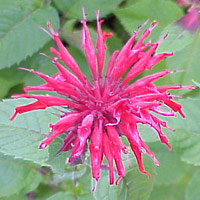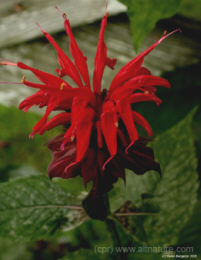---
YAAAAY NOW IT'S TIME FOR PLANT PROFILE!
Today's featured act will be performed by a lovely and exotic-looking lady known as bee balm, although she is sometimes called bergamot.


PLANT TYPE: Perennial
SCIENTIFIC NAME: Monarda didyma
ZONE / HARDINESS: 4 to 9.
MATURE PLANT SIZE: 24 to 48 inches high x 12 inches wide
LIGHT: Sunny location or in partial-day shade
FLOWERING PERIOD: July to August
SOIL TYPE: Rich, moist soil
pH RANGE: 6.5
KNOWN PESTS: Snails can be a problem in shady, moist locations where roots are kept cool and moist.
KNOWN DISEASES: Powdery mildew

The tuberous root produces an erect, slightly hairy square stem with a citruslike fragrance. The two-lipped scarlet flowers rest on a collar of red-tinged bracts with solitary terminal heads. The dark green leaves are 3 to 6 inches long, opposite, and ovate with serrated margins. The fruit is comprised of four nutlets resembling seeds.
Native to North America, bergamot received its botanical name from the sixteenth century Spanish physician, Nicholas Monardez, who first discovered and described it. It was called Oswego (or Otsego) tea by early American settlers because of its use by the Oswego Indians.
Bee balm flowers are brilliant additions to late-summer herb gardens and flower borders. Butterflies, hummingbirds, bees, and other nectar-seeking creatures covet the tubular flowers on the plant's rounded flower heads, and the leaves and flowers can also be made into tea. Other common names include horsemint, wild bergamot, and Oswego tea.
Bee balm flower colors include pink, red, and white; new double-flowered forms are also available. The plant blooms from early to late summer and grows 2 to 4 feet tall, depending on the variety. Some bee balm species tolerate wet soil and will thrive along a waterway or in a bog garden. Bee balm is susceptible to powdery mildew disease, so select resistant varieties. Under favorable growing conditions the plant can become invasive.


SPECIAL FEATURES
Easy care/low maintenance
Multiplies readily
Attracts hummingbirds
Attracts butterflies
Tolerates wet soil
PLANTING SITE SELECTION
Select a site with full sun to light shade and rich, well-drained soil. Some species tolerate wet soils, while others are adaptable to a wide range of soil moisture levels.
PLANTING INSTRUCTIONS
Plant in spring or fall, spacing plants 1 to 2 feet apart. Prepare garden bed by using a garden fork or tiller to loosen soil to a depth of 12 to 15 inches, then mix in a 2- to 4-inch layer of compost. Dig a hole twice the diameter of the plant's container. Carefully remove the plant from its pot and place it in the hole so the top of the rootball is level with the soil surface. Carefully fill in around the rootball and firm the soil gently. Water thoroughly.
FURTHER CARE
Apply a thin layer of compost each spring, followed by a 2-inch layer of mulch to retain moisture and control weeds. Water plants during the summer if rainfall is less than 1 inch per week. Remove spent flowers to keep plants looking tidy. After the first killing frost, cut stems back to an inch or two above soil line. Divide plants in spring every few years or when you notice the center of the plant dying out.
PROPAGATION / SOWING:
Seeds or division in spring and cuttings in summer. Seeds or division in spring and cuttings in summer. Sow seed in warm soil, 1/8 inch deep and 12 inches apart. Germination in about 2 weeks.
COMPANION PLANTING:
Bergamot attracts bees, making it an excellent plant to grow near vegetable gardens or orchards.
USAGE:
Aromatic, cosmetic, culinary, decorative, and medicinal. Dried leaves and flowers are used to scent sachets and potpourris. Bergamot also is used in lotions and baths. The leaves are used for tea and the flowers for salads or with fruit. With its long-lasting flowers, the plant itself is decorative. It is said to have some medicinal qualities.

---
Citation
http://en.wikipedia.org/wiki/Monarda
http://www.garden.org/plantguide/?q=show&id=2037
http://www.altnature.com/gallery/beebalm.htm
http://wiseacre-gardens.com/plants/perennial/beebalm.html
http://usagardener.com/how_to_grow_herbs/how_to_grow_bee_balm.php
---
III. Leaf Terminology
II. Flower Terminology
I. General Terminology
